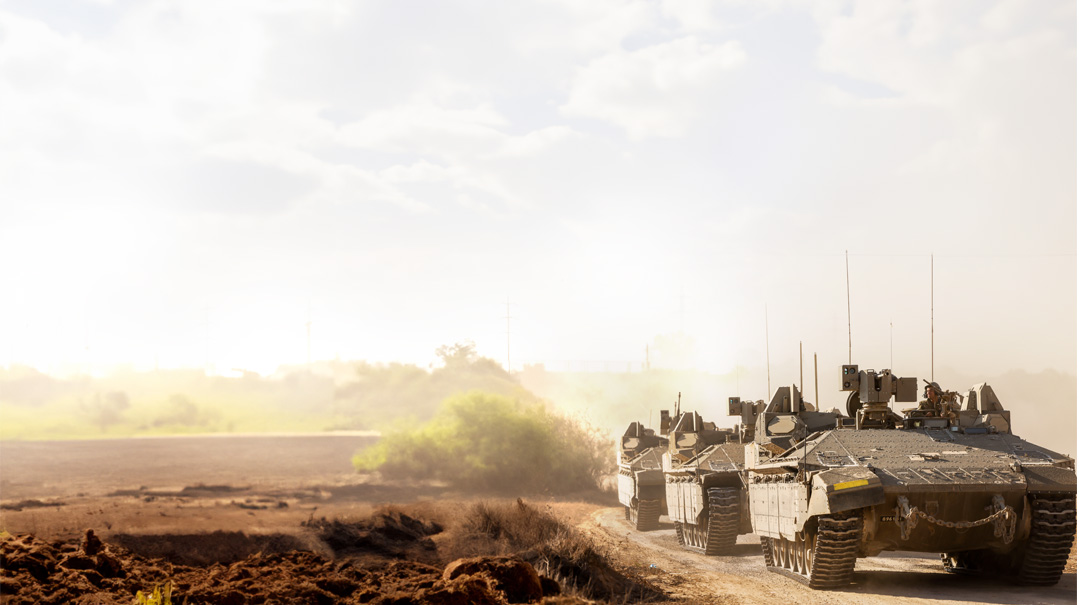Into Gaza

What resistance will the IDF face, what price will have to be paid to win, and will the world let Israel finish the job?

Down by the Gaza border, an Israeli army is assembled, the size of which hasn’t been seen for a generation. Hamas’s murderous attack last week has generated an overwhelming determination among the soldiers to bring down the terror army, and by the time these words are read, many of those soldiers might be deep in hostile territory, battling Iran’s well-equipped proxy. As Israel undertakes its first large-scale war in almost two decades, the unknowns loom large: What resistance will the IDF face, what price will have to be paid to win, and will the world let Israel finish the job?
Taking Aim
Unlike previous rounds of Israel-Hamas fighting, Israel’s war aims seem clear. “We’ll destroy the entity called Hamas,” said Defense Minister Yoav Gallant last week. Similar utterances from everyone from Netanyahu to the IDF brass demonstrate both a rare cohesion and determination. But beyond the tough words, there’s a great lack of clarity about what Hamas’s destruction actually means. Destroying the organization as a fighting force in a meaningful sense means not only killing its thousands of fighters and removing military materiel — it means ensuring the enclave’s pacification. That, in turn, requires a plan for the day after. Biden has warned Israel that reoccupation of Gaza would be a “big mistake,” but who will step in to ensure that Hamas doesn’t reconstitute when Israeli troops pull out? Shocked by the wanton slaughter, Israel is united in the conviction that Hamas has to go; whether that is a sufficiently clear war aim remains to be seen.
Offensive Motion
While Israel has been accused of war crimes for calling for a million residents to evacuate the northern Gaza Strip, the logic is to free the IDF to pound every suspected Hamas hideout ahead of a ground attack. But even after that softening-up, the army is expected to face formidable defenses in that most difficult of theaters: urban warfare. Hamas has built an enormous warren of tunnels — what the IDF dubs the “Gaza metro” — that contain everything from men to weaponry. Every building in northern Gaza could be booby-trapped, or contain the exit to an attack tunnel. Hamas will aim to maximize Gaza’s civilian deaths, to capitalize on Israel’s sensitivity to world opinion. The terror organization will also play its hostage card: with 200 Israelis and foreign workers known to have fallen into the killers’ hands, the Israeli public can expect to face horrific, ISIS-worthy scenes of captives held by their Hamas torturers.
Air Power
The air force will also have to operate carefully, with Hamas known to be equipped with large numbers of anti-aircraft missiles. The air force has other worries, though: After years of roaming freely across the Middle East, it’s not clear that their home bases are safe from the terrorists. Local residents around the Tel Nof base near Rehovot note that for hours after the Hamas offensive, jets didn’t take off in the way that they always do whenever Hamas attacks — possibly due to the massive rocket bombardment aimed at the base. Uzi Rubin, a former general and head of Israel’s missile development organization, warned in these pages a few years ago of precisely this scenario, and advocated developing a massive rocket force that could survive the neutralization of the air force. He was ignored, and here we are.
International Pressure
The wall-to-wall support for action in Gaza — literally unthinkable two weeks ago — is a product of the horrific nature of the attack, which has utterly shaken the Israeli psyche. For the first time, Israel’s left is thirsting for Hamas blood every bit as much as the right. But it’s Western leaders who could potentially act as a drag on the IDF completing its work. So far, center-left leaders such as President Biden and Britain’s opposition leader, Labour Party head Keir Starmer, have stood firmly behind Israel’s right to self-defense. But as Gaza’s civilian losses inevitably pile up, how long will they be able to withstand pressure from their parties’ left flanks? And if Western support drops, is Israel ready to become a pariah in order to destroy Hamas once and for all?
Trouble from Tehran
The formidable American aircraft carriers now cruising the eastern Mediterranean are in the area to act as a giant stick waved in Iran’s direction. Tehran’s long-term strategy of arming terror proxies from Gaza to Lebanon, Syria to Yemen and Iraq, has had its first big success, and Iran is eager for more. Hence the repeated attacks from Hezbollah in Lebanon on Israeli positions using anti-tank missiles over the last few days, and the evacuation of dozens of communities on Israel’s northern border. For now, it seems that Hezbollah doesn’t want a real conflict. But does the IDF have the resources to fight on a second front against Hezbollah? Would the US actually fight alongside Israel if Iran chose to make good on their threats and activate their other proxies? And if this war drags on, would Israel be able to launch a strike against Iran if Tehran decided to capitalize on Israel’s distraction, and make a dash for nuclear breakout?
Yesterday’s War
Beyond external and internal threats, the IDF could be held back by ossified thinking. On a recent podcast with a colleague of mine from Mishpacha’s Hebrew-language edition, a former senior IDF officer responded to the question of the day-after in Gaza with a shocking defense of the failed border wall. “We needed more watchtowers and we have to go back to making a 400-meter buffer zone in front of them,” he said. As an example of yesterday’s generals fighting yesterday’s war, it was hard to beat. It was clear that like the Maginot and Bar Lev lines, a concept of a static defense had failed, and yet he was insisting on doubling down despite the deadly failures. With almost the entire defense establishment implicated in the disaster, how much more of the IDF’s operational doctrine will be found lacking?
AS Israel’s forces prepare to enter the beast’s lair, assembling the armed might of one of the world’s most advanced militaries, a line echoes in my mind from Bilaam, an ancient local enemy.
Gazing at the ranks of the Jewish People in the Midbar, Bilaam gave an unforgettable testament to the miracle that is Am Yisrael. “Mi manah afar Yaakov — Who counts the dust of Yaakov?” he asked. According to Rav Hirsch, he was referring to “afriyus” — material quantity, observing that when it comes to the Jews, physical numbers never matter because we exist on a different plane.
Last week, we received a stinging reminder of that eternal truth. The most advanced, high-tech border wall in the world was breached by a band of murderous peasants, and all the tech was for naught.
But as the IDF goes on the offensive, the converse is true: We may or may not have the weapons to do the job, but when Hashem is with us, when has that ever mattered?
(Originally featured in Mishpacha, Issue 982)
Oops! We could not locate your form.







